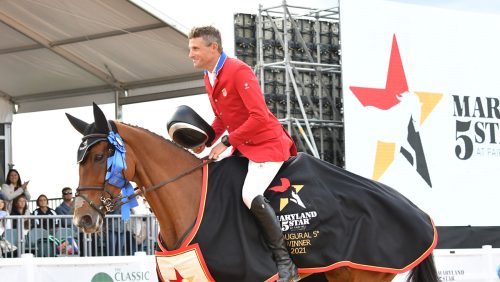With 29 numbered obstacles and more than 40 jumping efforts, this year’s Rolex Kentucky CCI**** course is as big and bold as ever.
An optimum time of 11 minutes and 15 seconds at a speed of 570 meters per minute over 6400 meters, Derek di Grazia’s course will prove tough, and those that aren’t accurate, bold and fit might struggle.
We took a walk with di Grazia, now in his sixth year of designing at Rolex, to learn more about some of the key combinations.
The Head Of The Lake
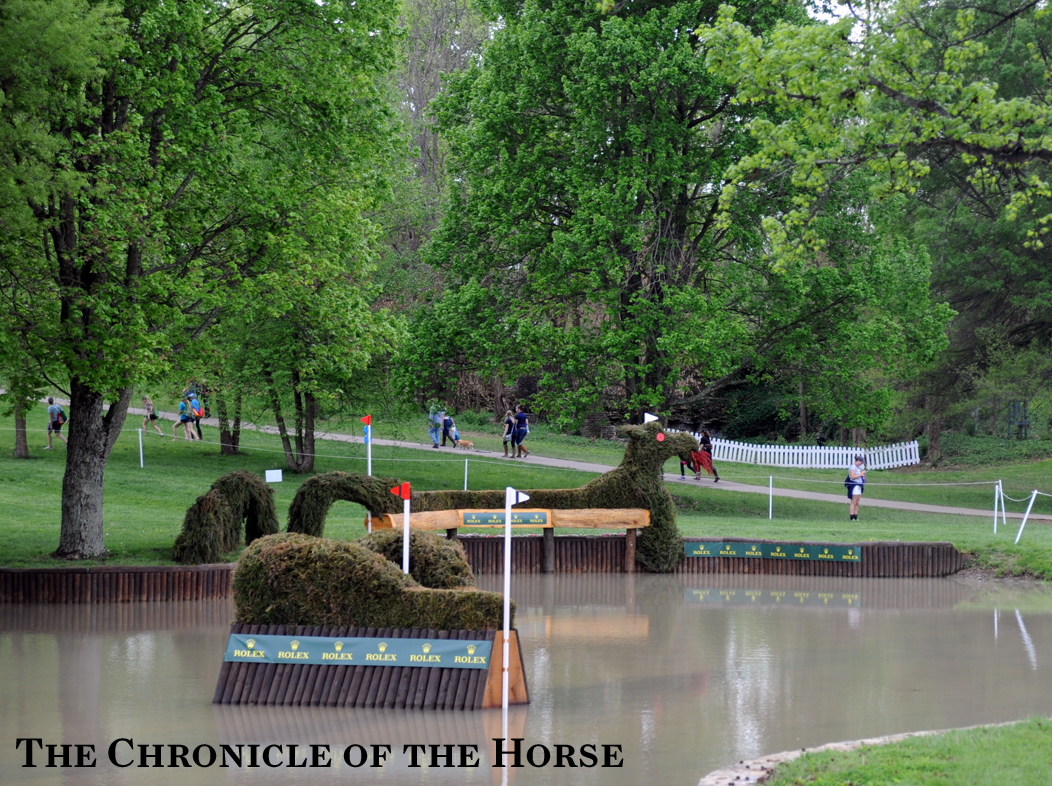
11AB, part of the Head Of The Lake. Photo by Lindsay Berreth.
The most popular place to be on Saturday, the Head Of The Lake comes early this year at the 4-minute mark.
Riders will jump a big table, fence 10, then go about seven strides to a brush drop into water at 11A.
The B element is a corner in the water, followed by a right curve to a bounce bank out at 12AB.
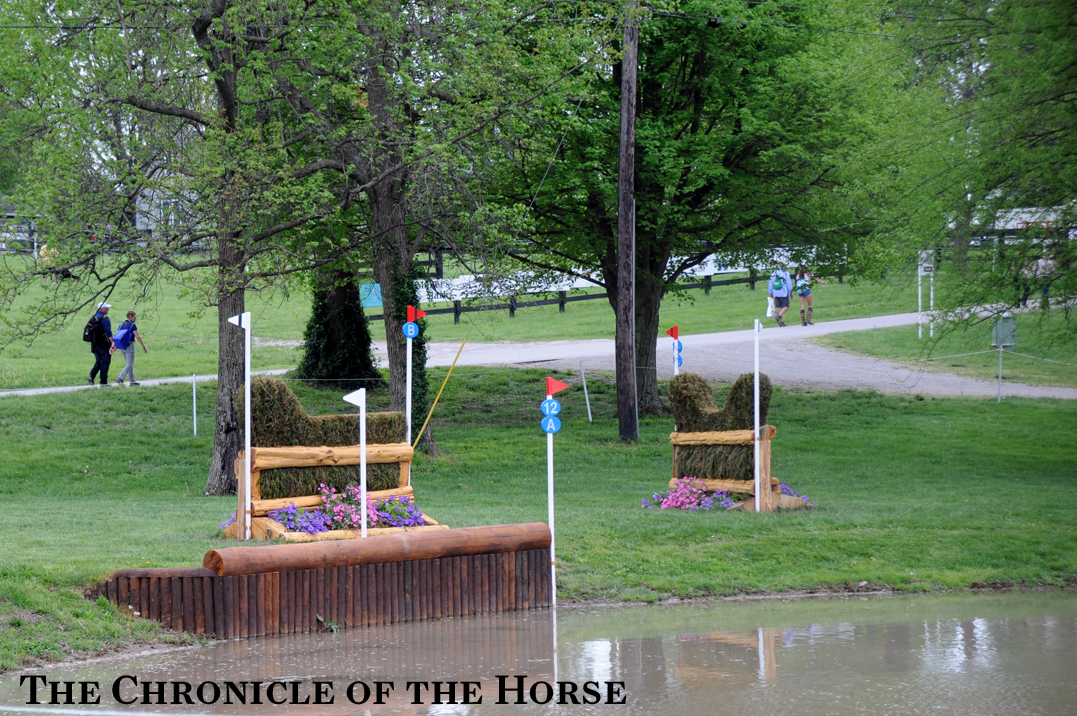
12AB, the rest of the Head Of The Lake. Photo by Lindsay Berreth.
“This place will be packed with people, and the horses and riders come down here, and this area is just electric for everybody,” said di Grazia. “The horses should be quite fresh. As they come down the hill, there’s a fairly decent sized table coming down the hill. The horses will really jump up in the air there, but at the same time, they’re going to have quite a lot of momentum coming down the hill. When they land they’ve got about seven strides until they jump into the water. They have to make sure as they come down the hill that they get some sort of control, so they don’t go in too big into the water, because right away once they land in the water they’ve got the turn to the brush corner.”
Di Grazia said riders must be on the ball, or they’ll get caught out. There is an optional B element, a cabin on the grass, then a canter back into the water to go up the bounce bank.
Curving Brushes
ADVERTISEMENT
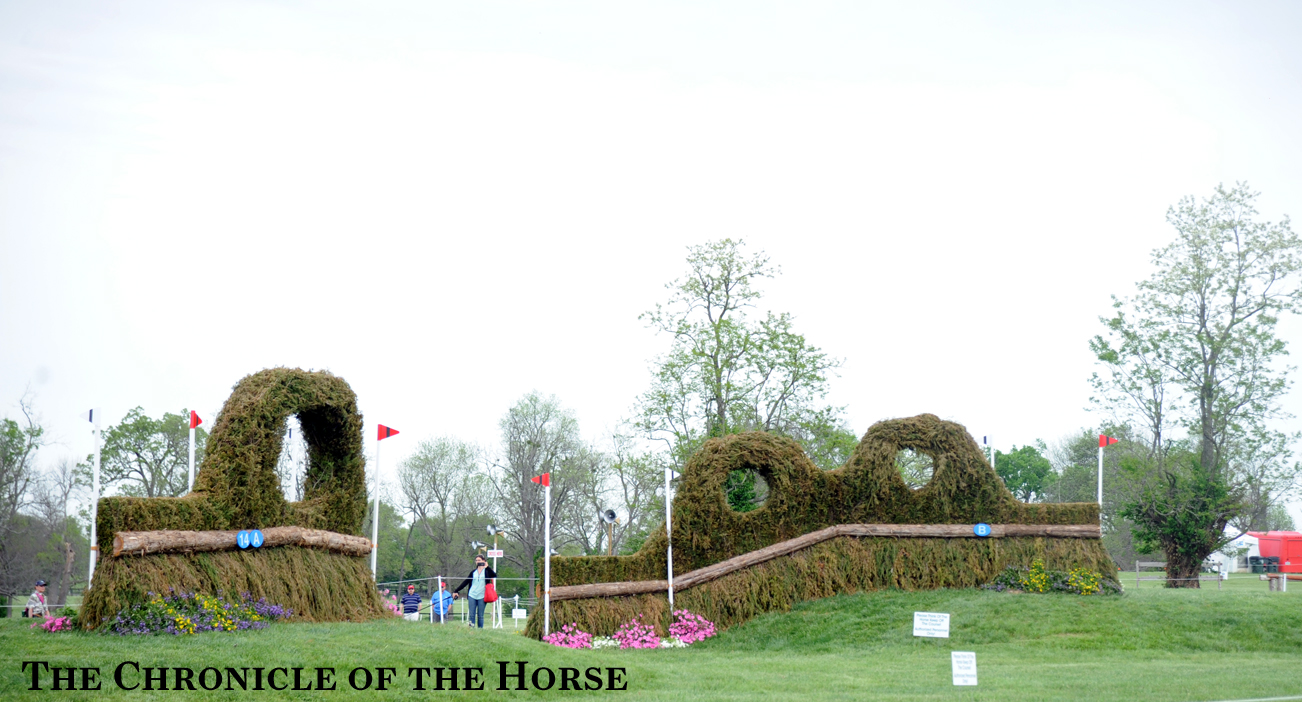
The line over the brushes goes from the left side of the first hole in the brush to the right side of the second brush. Photo by Lindsay Berreth.
After the Head Of The Lake and fence 13, a table, horses and riders will approach 14AB, two very skinny brushes on top of two mounds.
“They’ve come from the Head of the Lake, the horses are galloping up the hill, and the big thing is as they approach this fence, basically it’s a pretty straight line between the two fences,” said di Grazia. “You jump in over a narrow brush, but riders don’t know how far their horses are going to jump down the slope. It’s an unknown. Just from walking it, they have to know that the distance from the first one to the second one is just a little bit steady. I think they have to know they can’t come too quick.
“If they come too quick, that second one is going to come up very quick, and they would have a good chance of running right by it,” he continued. “The riders know they’ve got to have a horse that’s underneath them and make a good jump over the first one, then I think it’s pretty much a steady ride and holding the line throughout the combination. There is a long way, but I don’t anticipate a lot of people taking it because I think the straight way just looks a lot nicer to me. The long way will take time.”
The Hollow
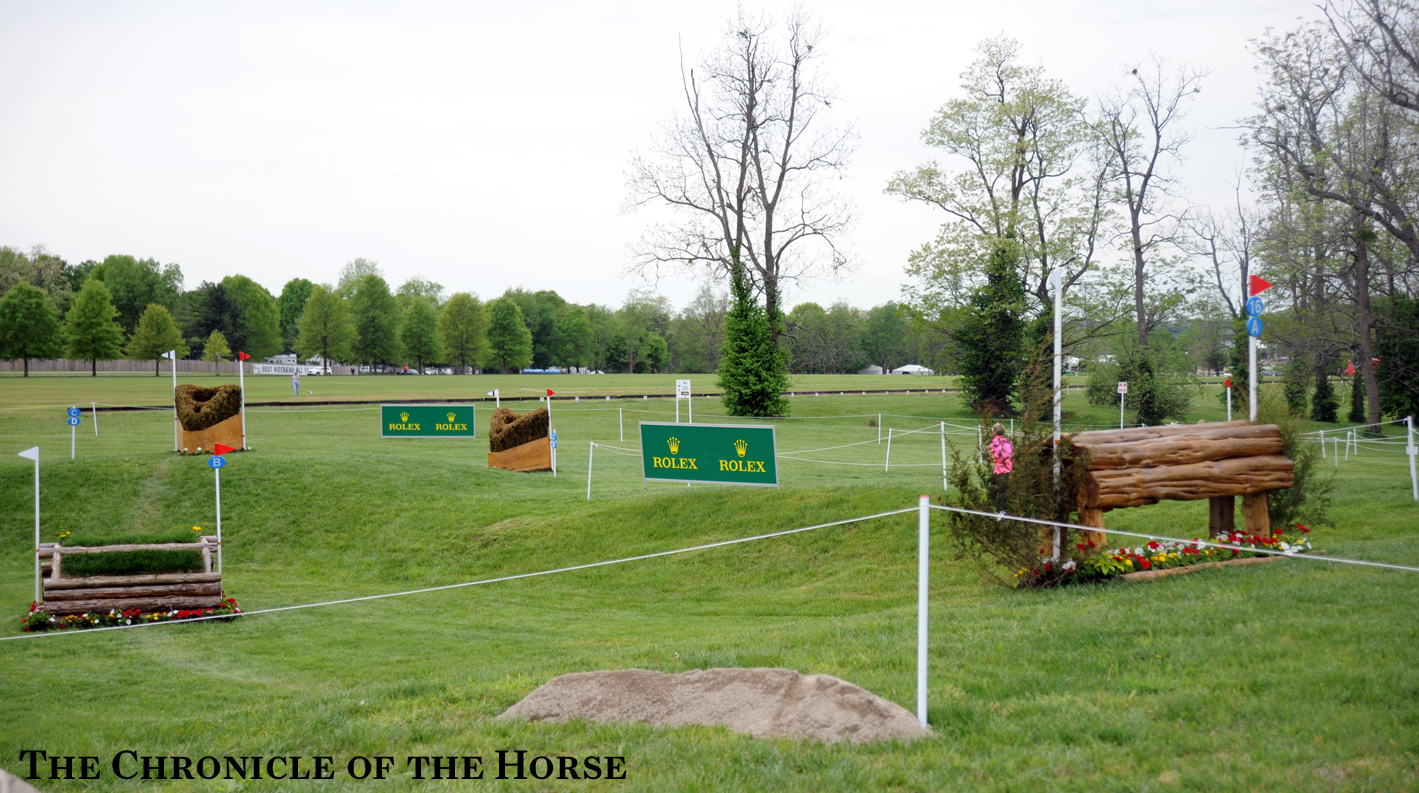
The Hollow complex. Photo by Lindsay Berreth.
After the Curving Brushes, riders jump a nice, big open oxer at 14, then make their way to the furthest point in the course, The Hollow, 15ABC.
This year the question doesn’t utilize the bank, but still tests the horses’ balance. A is a big log drop, then four strides to a sod-top cabin, then out over a narrow brush that’s 4’7” tall.
The alternate is another sod-top cabin to a different brush element (the one on the right).
“The big thing here is the riders have a choice. Each fence has its’ pluses and minuses. They have to make the decision of what’s going to be the best for their horse at the time they come here in the course,” said di Grazia. “As they come from A to B, it should be in four strides, but you’ll see some probably do it in five. Then the other thing you have to worry about is when you go from A to B, if you jump B quite strong, then from B to C and D, it’s straight up the hill four strides, but if you’re too quick, then you’ll run past that distance that’s there. You have to make sure you’re not overly strong to the B at the bottom, then as you go up the hill you can be a bit steady to the one at the top.”
Land Rover Landing
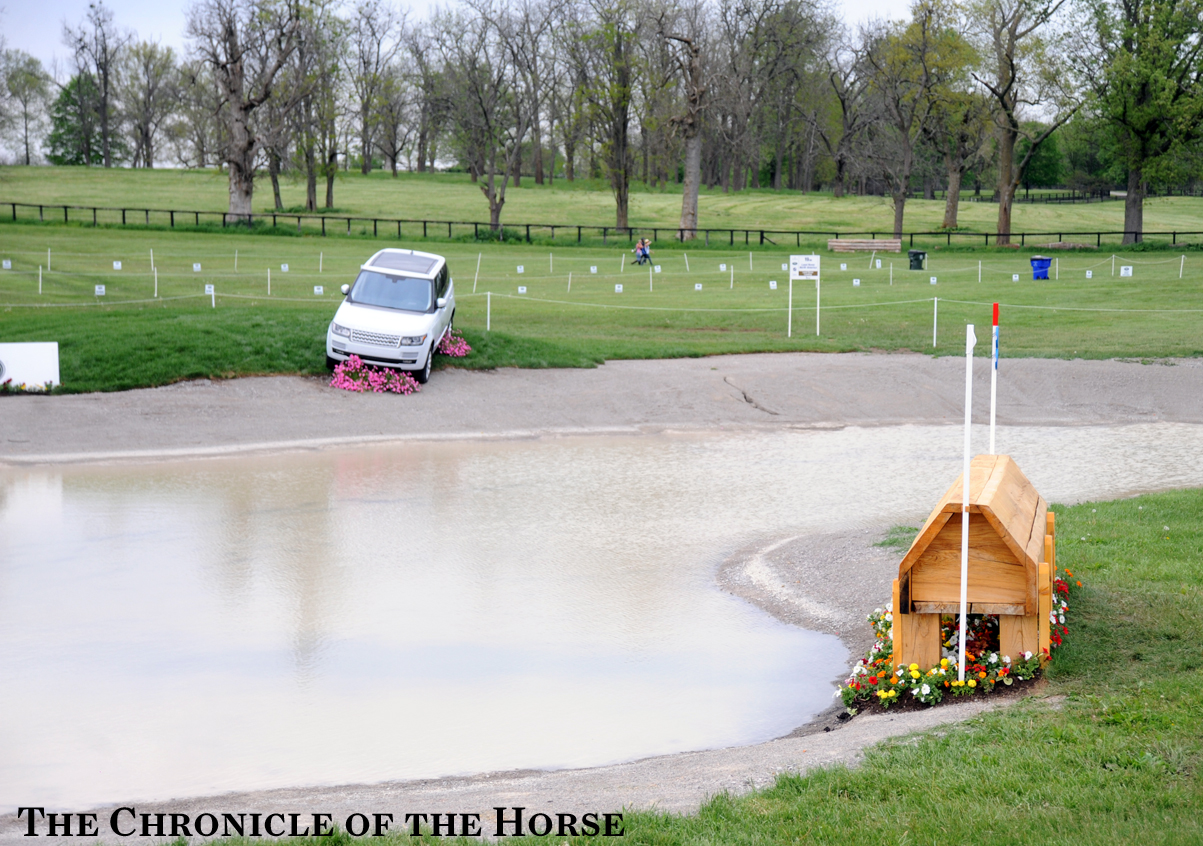
ADVERTISEMENT
Photo by Lindsay Berreth.
There’s a new water jump on course this year, making it five times horses will get their feet wet.
Riders will jump the Fallen Tree, 18, a beautiful jump that debuted at the 2010 Alltech FEI World Equestrian Games, then make a right turn to set up for the new Land Rover Landing water complex at 19AB.
A simple rolltop in leads to a left-handed turn to an open corner.
“The relationship between the tree and coming through the water, the way it’s set up seems like a good question to be doing this year. In future years, the water is big enough that we can do a lot of different things here. I think it will be a very useful complex in the future,” said di Grazia. “This year, when they land from the tree, they’ve got to land and get themselves back together. As they come through the turn, they have to make sure they get the horses straight so the horses are not bearing out through the left shoulder,” he continued.

The open corner out of the water. Photo by Lindsay Berreth.
There is a corner option if you land right, but it will take some time. They will then have a short sprint to 20, the Footbridge.
“By the seven minute mark, the horses should have a lot of run in them, but at the same time, I think the riders have to be able to land, keep their position and right away be able to get on to the line to jump the corner,” said di Grazia.
Normandy Bank

Derek Di Grazia explains the bank to angled cabins. Photo by Lindsay Berreth.
The Normandy Bank, 21ABC, comes after the Footbridge at about the 8 minute mark. Di Grazia took off the rail from the top and put two extremely angled cabins at the base of the mound.
“On their approach, the riders really have to know their line because once they jump up there it will happen quite quickly. Their horse have to be straight to be able to jump across these two horse park barns,” he said. “It should be four strides into the first barn, then one stride in between. I think it’s a good rider test because they have to be able to jump up, make that turn, then the horses have to be straight. It will be an interesting place to watch. If you’re going well up until now, you want to make sure you have a good ride through here. You don’t want a run out here at one of the barns. At this point, you have to break down and see what you’ve got left and hopefully you’ve still got a lot because there’s still quite a lot to do in the course.”
After this complex, there’s a good gallop to give horses a breather, or to make up some time, before they come to a tobacco barn at 22 and an open corner at 23.







